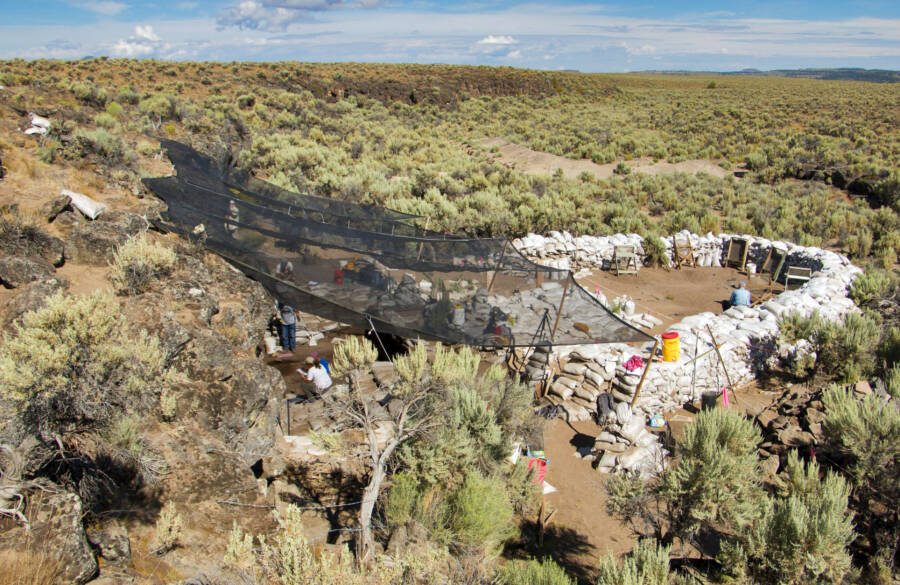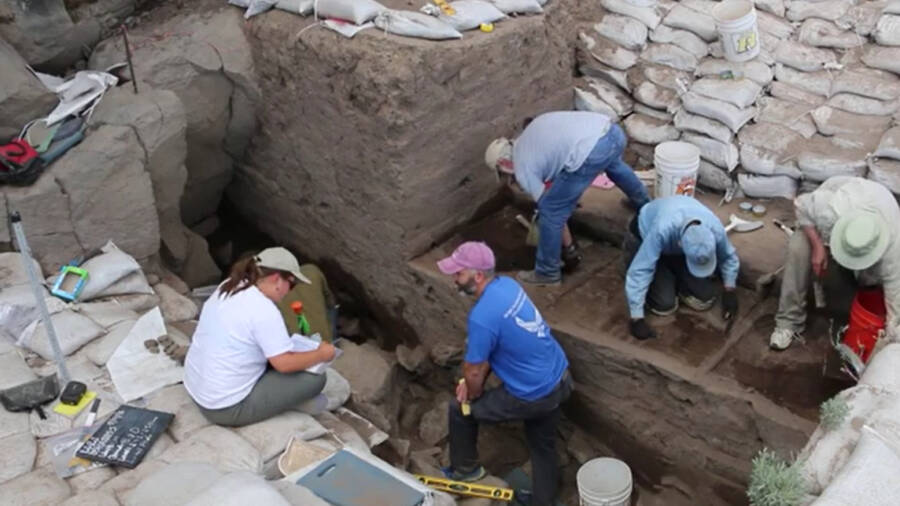Archaeologists at the Rimrock Draw Rockshelter in eastern Oregon determined the settlement's age through radiocarbon dating of camel teeth found there in 2012.

University of OregonThe Rimrock Draw Rockshelter in eastern Oregon.
Archaeologists from the University of Oregon may have discovered remnants from the oldest human settlement in North America at the Rimrock Draw Rockshelter.
The site, located in eastern Oregon, has been of interest to the University of Oregon’s field archaeology team and the Bureau of Land Management (BLM) since 2011.
Throughout the more than decade-long excavation there, the team has uncovered several items of interest, including a stone scraper imbued with bison blood and pieces of camel teeth.
Radiocarbon dating suggests that some of these items are as old as 14,900 years. Adjusted to a calendar scale, that’s 18,250 years, making these finds arguably the oldest examples of human occupation in North America.

Other contenders for North America’s oldest site of human occupation include Pennsylvania’s Meadowcroft Rockshelter. Testing confirms that the Meadowcroft site is at least 16,000 years old — but there is evidence that the figure stretches back 19,000 years based on a piece of charcoal found in a fire pit. Testing at another site, Idaho’s Cooper’s Ferry, in 2022 found that the site also dated back to 16,000 years ago.
The process of dating the Oregon site began with extracting camel teeth fragments in 2012. Archaeologists found these teeth under a layer of volcanic ash from an eruption of Mount St. Helens nearly 15,000 years ago.
Radiocarbon dating on the tooth’s enamel found that it dated back to 18,250 years ago.
Other items included two stone scrapers, one imbued with bison blood. The excavation team found these artifacts even deeper in the ground, strengthening the assertion that the site may be older than 18,000 years.
“The identification of 15,000-years-old volcanic ash was a shock, then (the) 18,000-years-old dates on the enamel, with stone tools and flakes below were even more startling,” Patrick O’Grady, who led the excavation, said in a statement on the BLM website.

Bureau of Land ManagementUniversity of Oregon’s Museum of Natural and Cultural History Archaeological Field School excavates the rockshelter.
For the excavation team, the findings have been incredible and full of promise.
“It’s not so much that we have such old dates, but that we’re getting consistent results,” O’Grady stated, as per Ancient Origins. “This site is beautiful in that sense because … for the past 11 years, we’re actually seeing something that’s preserved through time that dates from about 7,000 years back to 18,000 years. And that’s magic.”
With evidence pointing to the site dating to 18,000 years ago and potentially beyond, experts will have even more evidence calling the once-popular Clovis-first hypothesis into question.
The Clovis Hypothesis states that the Clovis people first inhabited North and South America 13,000 to 12,600 years ago through a uniquely unfrozen stretch of Canada. These ancient people are characterized by their signature Clovis points, or fluted projectiles.
If the dates of the findings at the Oregon rockshelter are accurate, they have the potential to rewrite ancient American history.
“This is a very exciting development for the archaeological community,” Heather Ulrich, BLM Oregon/Washington Archaeology lead, stated on the BLM Website. “Thanks to the partnership with Dr. O’Grady and the University these new dates push our archaeological knowledge of human occupation in North America even farther, perhaps the oldest yet!”
“We have been on the forefront of this, the study of this, since the early 20th century,” Lexie Briggs, with the University of Oregon Museum of Natural and Cultural History, stated to the Salem Statesman Journal. “We are discovering how people have lived in Oregon for as long as there have been people in Oregon, and for that matter, North America.”
After learning about the Rimrock Draw Rockshelter, discover the story of Gobekli Tepe, the oldest temple in the world that archaeologists are still struggling to understand. Then, dive into 14 of history’s most important archaeological discoveries.





